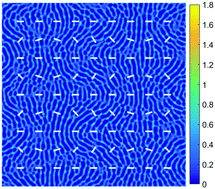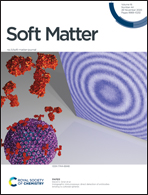Effects of spatially-varying substrate anchoring on instabilities and dewetting of thin nematic liquid crystal films
Abstract
Partially wetting nematic liquid crystal (NLC) films on substrates are unstable to dewetting-type instabilities due to destabilizing solid/NLC interaction forces. These instabilities are modified by the nematic nature of the films, which influences the effective solid/NLC interaction. In this work, we focus on the influence of imposed substrate anchoring on the instability development. The analysis is carried out within a long-wave formulation based on the Leslie–Ericksen description of NLC films. Linear stability analysis of the resulting equations shows that some features of the instability, such as emerging wavelengths, may not be influenced by the imposed substrate anchoring. Going further into the nonlinear regime, considered via large-scale GPU-based simulations, shows however that nonlinear effects may play an important role, in particular in the case of strong substrate anchoring anisotropy. Our simulations show that instability of the film develops in two stages: the first stage involves formation of ridges that are perpendicular to the local anchoring direction; and the second involves breakup of these ridges and formation of drops, whose final distribution is influenced by the anisotropy imposed by the substrate. Finally, we show that imposing more complex substrate anisotropy patterns allows us to reach basic understanding of the influence of substrate-imposed defects in director orientation on the instability evolution.



 Please wait while we load your content...
Please wait while we load your content...